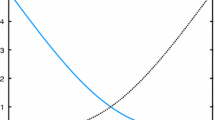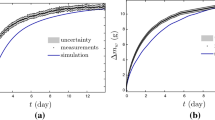Abstract
A numerical approach for moisture transport in porous materials like concrete is presented. The model considers mass balance equations for the vapour phase and the water phase in the material together with constitutive equations for the mass flows and for the exchange of mass between the two phases. History-dependent sorption behaviour is introduced by considering scanning curves between the bounding desorption and absorption curves. The method, therefore, makes it possible to calculate equilibrium water contents for arbitrary relative humidity variations at every material point considered. The scanning curves for different wetting and drying conditions are constructed by using third degree polynomial expressions. The three coefficients describing the scanning curves is determined for each wetting and drying case by assuming a relation between the slope of boundary sorption curve and the scanning curve at the point where the moisture response enters the scanning domain. Furthermore, assuming that the slope of the scanning curve is the same as the boundary curve at the junction point, that is, at the point where the scanning curve hits the boundary curve once leaving the scanning domain, a complete cyclic behaviour can be considered. A finite element approach is described, which is capable of solving the non-linear coupled equation system. The numerical calculation is based on a Taylor expansion of the residual of the stated problem together with the establishment of a Newton–Raphson equilibrium iteration scheme within the time steps. Examples are presented illustrating the performance and potential of the model. Two different types of measurements on moisture content profiles in concrete are used to verify the relevance of the novel proposed model for moisture transport and sorption. It is shown that a good match between experimental results and model predictions can be obtained by fitting the included material constants and parameters.
Similar content being viewed by others
References
Ahlgren, L.: Moisture fixation in porous building materials. Doctoral Thesis, Division of Building Materials, Lund Institute of Technology, Report 36, Lund (1972)
Åhs, M.: Moisture redistribution in screeded concrete slabs. Division of Building Materials, Lund Institute of Technology, Report TVBM-3136 (2007)
Argyris J.H., Vaz L.E., William K.J.: Integrated finite-element analysis of coupled thermoviscoplastic problems. J. Therm. Stress. 4, 121–153 (1981)
Arvidsson J., Claesson J.: Isothermal moisture flow in building materials: modelling, measurements and calculations based on Kirchhoff’s potential. Build. Environ. 35, 519–536 (2000)
Bathe K.J.: The finite element procedures. Prentice Hall, Englewood Cliffs, New Jersey (1996)
Bennethum L.S., Cusham J.H.: Multicomponent, multiphase thermodynamics of swelling porous media with electroquasistatics: I. Macroscale field equations. Transp. Porous Med. 47, 309–336 (2002)
Celentano D., Oňate E., Oller S.: A temperature-based formulation for finite element analysis of generalized phase-change problems. Int. J. Numer. Methods Eng. 37, 3441–3465 (1994)
Daïan J.F.: Condensation and isothermal water transfer in cement mortar: part II. Transient condensation of water vapor. Transp. Porous Med. 4, 1–16 (1989)
De Groot S.R., Mazur P.: Non-equilibrium thermodynamics. Dover Publications Inc., New York (1983)
Everette D.H.: A general approach to hysteresis, an alternative formulation of the domain model. Trans. Faraday Soc. 51, 1551–1557 (1955)
Frandsen H.L., Svensson S., Damkilde L.: A hysteresis model suitable for numerical simulation of moisture in wood. Holzforschung 61, 175–181 (2007)
Hedenblad, G.: Moisture permeability of mature concrete, cement mortar and cement paste. Doctoral Thesis, Division of Building Materials, Lund Institute of Technology, Report TVBM-1014, Lund (1993)
Huang H.C., Tan Y.C., Liu C.W., Chen C.H.: A novel hysteresis model in unsaturated soil. Hydrol. Process. 19, 1653–1665 (2005)
Hughes T.J.R.: Unconditional stable algorithms for non-linear heat conduction. Comput. Methods Appl. Mech. Eng. 10, 135–139 (1977)
Hughes T.J.R.: The finite element method, linear static and dynamic finite element analyzes. Prentice-Hall International Editions, Englewood Cliffs, New Jersey (1987)
Johannesson, B.F.: Transport and sorption phenomena in concrete and other porous media. Doctoral Thesis, Division of Building Materials, Lund Institute of Technology, Report TVBM-1019 (2000)
Johannesson B.F.: Prestudy on diffusion and transient condensation of water in cement mortar. Cem. Concr. Res. 32, 955–962 (2002)
Kool J.B., Parker J.C.: Development and evaluation of closed-formed expressions for hysteretic soil hydraulic properties. Water Resour. Res. 23, 105–114 (1987)
Mualem Y.: Extension of the similarity hypothesis used for modeling the soil water characteristics. Water Resour. Res. 13, 773–780 (1977)
Nyman U., Gustafsson P.J., Johannesson B., Hägglund R.: A numerical method for the evaluation of non-linear transient moisture flow in cellulosic materials. Int. J. Numer. Methods Eng. 66, 1859–1883 (2006)
Pihlajavaara, S.E.: On the main features and methods of investigation of drying and related phenomena in concrete. Doctoral Thesis, State Institute for Technical Research, Publication No. 100, Helsinki (1965)
Topp G.C., Miller E.E.: Hysteresis moisture characteristics and hydraulic conductivities for glass-bead media. Soil Sci. Soc. Am. Proc. 30, 156–162 (1966)
Zeinkiewicz O.C., Taylor R.L.: The finite element method. McGraw-Hill, London (1989)
Author information
Authors and Affiliations
Corresponding author
Rights and permissions
About this article
Cite this article
Johannesson, B., Nyman, U. A Numerical Approach for Non-Linear Moisture Flow in Porous Materials with Account to Sorption Hysteresis. Transp Porous Med 84, 735–754 (2010). https://doi.org/10.1007/s11242-010-9538-3
Received:
Accepted:
Published:
Issue Date:
DOI: https://doi.org/10.1007/s11242-010-9538-3




